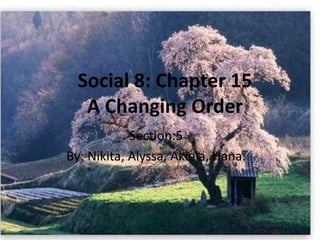
Social Chapter 15 scetion:5
- 1. Social 8: Chapter 15 A Changing Order Section:5 By: Nikita, Alyssa, Akiela, Hana.
- 2. A Changing Order Mutsuhito selected a new name during the first year of his reign. Meiji meaning “enlightened rule”. Emperors had been in the background during the years of Tokugawa shogunate. They lived secluded lives in the imperial palace in Kyoto hidden away from people. The Emperor was the supreme ruler of Japan, but the shogun had all the power. The three year period beginning in 1867 when the young emperor came to the throne is known as the Meiji Restoration.
- 3. A Changing Order Cont’d The government emphasized the importance of the emperor. He had been restored to his rightful place. The government emphasized the importance of the emperor; he had been restored to his rightful place as head of Japan. Emperor Meiji’s reign lasted until his death in 1912; this is known as the Meiji period. The spread of education, wealth of the merchant class, and the increase in commerce during the last century of the Edo era has set the scene for change in Japanese society.
- 4. New Ideas About Government The samurai who had led the fight to defeat the shogunate and restore the emperor now became his advisors. This oligarchy unelected group of powerful leaders took control of the government and ruled the country. The advisors then realized that Japan would have to change, in order to keep westerners from taking over Japan as they had done to China. Japan needed economic, and military power that could take its place proudly in the modern world.
- 5. New Ideas About Gov’t Cont’d The Meiji leaders had 2 goals: To create a strong central government that could unite the country and rule effectively. To create a form of government closer to the democracies of the west. Rallying around the emperor: The emperor had always been a powerful symbol to the Japanese people. He was traditionally believed to be the descendent of the sun goddess Amaterasu.
- 6. New Ideas For Gov’t Cont’d The Meiji leaders began their transformation by ensuring the importance of their emperor of a strong nation. Their first step was to move the imperial court from Kyoto to Tokyo new name for Edo, the capital. The Meiji leaders believed that with the emperor and the government in the same place, the connection between the two would be obvious to the people.
- 7. Losing Power In order to increase the power of the emperor and the government, the Meiji leaders encouraged the daimyo to turn over their lands to the state. The daimyo were given pensions as compensation , the Meiji leaders pointed out that the land had actually always been the property of the government. The samurai system was abolished by the government.
- 8. Losing Power Cont’d The Samurai were given a tax-free income, but this did not last long. It was clear the samurai had to get jobs. The feudal system in Japan had now come to an end. In the future, only the government would have the right to collect taxes.
- 9. Opportunities For The Common People Commoners were given new rights after the Charter Oath. They were allowed to choose where they would live and the occupation they would pursue. For centuries they were known only by their given names and the work they did, they were given names and work, they were now allowed to have a family surname.
- 10. Opportunities For The Common People Cont’d The old rules about dress were no longer enforced. Peasants were made the outright owners of their land. Legislation was passed to end discrimination against the outcasts.
- 11. Education Reform The Meiji leaders wanted to reform the Japanese education system to bring it close to those of the west. It was modeled on the American and the French Systems. In the early 1880’s, the leaders decided that education needed to be based on traditional values and centred on developing respect for the emperor. Educated Individuals would make rich and strong country.
- 12. Education Reform Cont’d Japan stayed the same, despite the Charter Oath. Traditional family patterns did not change. Fathers continued to have legal authority for their families. This made family decisions about education, marriage, jobs, property. Family members who defied father’s authority became a nonentity non-person. Class distinctions remained. Common people still looked up to their superior. Old upper classes still held prejudices about common people.
- 13. Education Reformed Cont’d Rural peasant’s lives remained the same. Land taxes were very high, a lot of the country ended up in the hands of money lenders or landowners. Peasant framers ended up renting or sharecropping land owned by others and had to pay rent even when crops failed. Many could not afford to send their children, especially their daughters to school. In rural areas, many remained illiterate until the end of the Meiji period.
- 14. Pictures